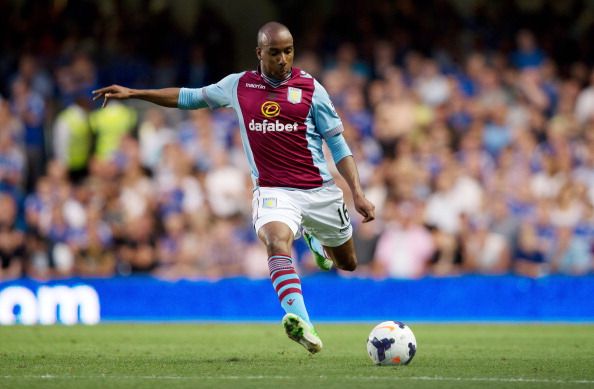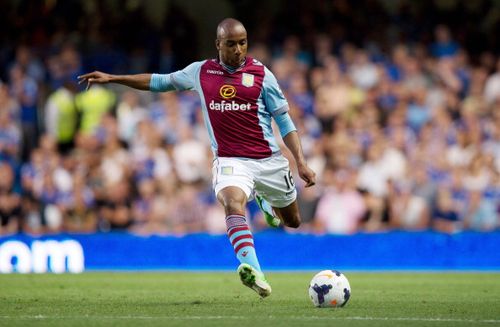
The fabulous reincarnation of Fabian Delph

Fabian Delph is finally showcasing his talent on the big stage
“He’s got great talent, he can pass the the ball, he covers the ground, he loves to tackle,” enthused Simon Grayson as he spoke to the BBC about a teenager making a big impression at Leeds United. “He’s a young kid so he’s going to go through ups and downs in his career, but the lad’s got huge talent.”
Simon Grayson’s comments regarding Fabian Delph in March 2009 were remarkably prescient. To say that Delph has experienced ups and downs since joining Aston Villa would be something of an understatement.
In recent months, however, the Bradford-born midfielder has emerged as one of Paul Lambert’s most important players.
Martin O’Neill took Fabian Delph to Aston Villa in August 2009, when he was an 19-year-old starlet. At the time, Manchester United, Everton, Manchester City, Tottenham, Arsenal, and Newcastle had all shown interest in the youngster before Leeds eventually agreed to sell their prized asset to Aston Villa for an estimated £8m. Leeds chairman Ken Bates praised the manner of Villa’s approach for Delph, and it was perhaps this respectful approach which helped Villa secure the player ahead of other interested clubs.
Managers who had circled the Leeds youngster took note of Delph’s authoritative all-action style as he played 42 games for Leeds United during the 2008/2009 season. All six of Delph’s goals that year were eye-catching, particularly his brace against Walsall where the youngster made strong, lung-bursting runs from midfield and confidently struck home from distance. Gary McAllister, who would later work with Delph again under Gerard Houllier, predicted a bright future, “Fabian Delph has come through our academy and is an exciting talent as well as being very competitive. He is a natural footballer.”
Following Delph’s arrival at Villa, he made his debut against Fiorentina on 8 August 2009 when Villa beat the Viola 1–0. The teenager showed glimpses of his natural attacking instincts as he confidently surged forward and unleashed several stinging shots towards goal. It was a performance that showed the player’s exuberance and tenacity, but unfortunately the development of Delph was stunted in his debut season due to a lack of first team football.
In 2009, Martin O’Neill was attempting to build a squad capable of qualifying for the Champions League and it appeared that the Villa manager saw Delph as a player for the future, rather than a player for the present. In the 2009-10 season, Delph made only nine starts for the club, five of which came in Cup competitions. Frustratingly for Delph, Martin O’Neill didn’t believe in rotation and the youngster found that his path to the first team was blocked by players such as Milner, Petrov, Reo-Coker, Gardner and Sidwell.
In terms of Delph’s development, a pattern emerged during Martin O’Neill’s four years at the club, in that he never really attached much importance to the position of defensive midfield, and instead preferred to share out defensive duties, or muddle through by converting a long list of players to play the position.
An example of O’Neill’s tinkering came after Stiliyan Petrov’s first season at the club where Petrov struggled in the attacking-midfield role. Villa had invested £7m on a player who had scored freely for Celtic, but following Petrov’s move to England, the Bulgarian found it difficult to cope with the pace of the Premier League. In subsequent seasons, Petrov was re-deployed in other central midfield roles aided by Nigel Reo-Coker who was meant to add strength and legs to Villa’s midfield. Unfortunately, the former West Ham midfielder lacked skill and tactical discipline and Reo-Coker frequently voiced his discontent at playing defensive-midfield rather than his preferred box-to-box midfield position.
Many Premier League clubs were using a player in the Makelele role, where teams fielded a defensive midfielder who could win the ball cleanly and swiftly distribute possession to a team mate. Martin O’Neill, however, was fairly dismissive of modern football trends and preferred to play with a two-man midfield without assigning specific holding duties to any player. Petrov and Barry, for instance, were competent when in possession but lacked mobility. Milner and Petrov were slightly better due to Milner’s selfless running, but following the departures of Barry and Milner, Steve Sidwell failed to make an impact at the club and Villa were again forced to rebuild the midfield following a high turnover of players.
Months of frustration during the 2009-2010 season saw Fabian Delph earn the reputation of a hard man in training due to his spiky tackles and tenacious appetite. Martin O’Neill had identified technical flaws in Delph’s game which the coaches sought to correct at Bodymoor Heath, “He can learn, because his body is open up to injury and the slightest awkward turn and twist could mean he will do himself some damage,” O’Neill told the Birmingham Mail in February 2010.
Regrettably, O’Neill’s advice was not heeded by an over-eager Delph who then ruptured his cruciate ligament a few months later and was removed from the training ground on a stretcher. The youngster’s painful experience was something he was unlikely to forget as he remained injured for the next eight months. Oscar Wilde once said that, “experience is simply the name we give our mistakes” and Delph’s mistake might have been avoided had he only listened to Martin O’Neill’s advice. In any event, the painful error proved to be a harsh lesson in the youngster’s development as Delph remained plagued by injuries for the next two seasons.